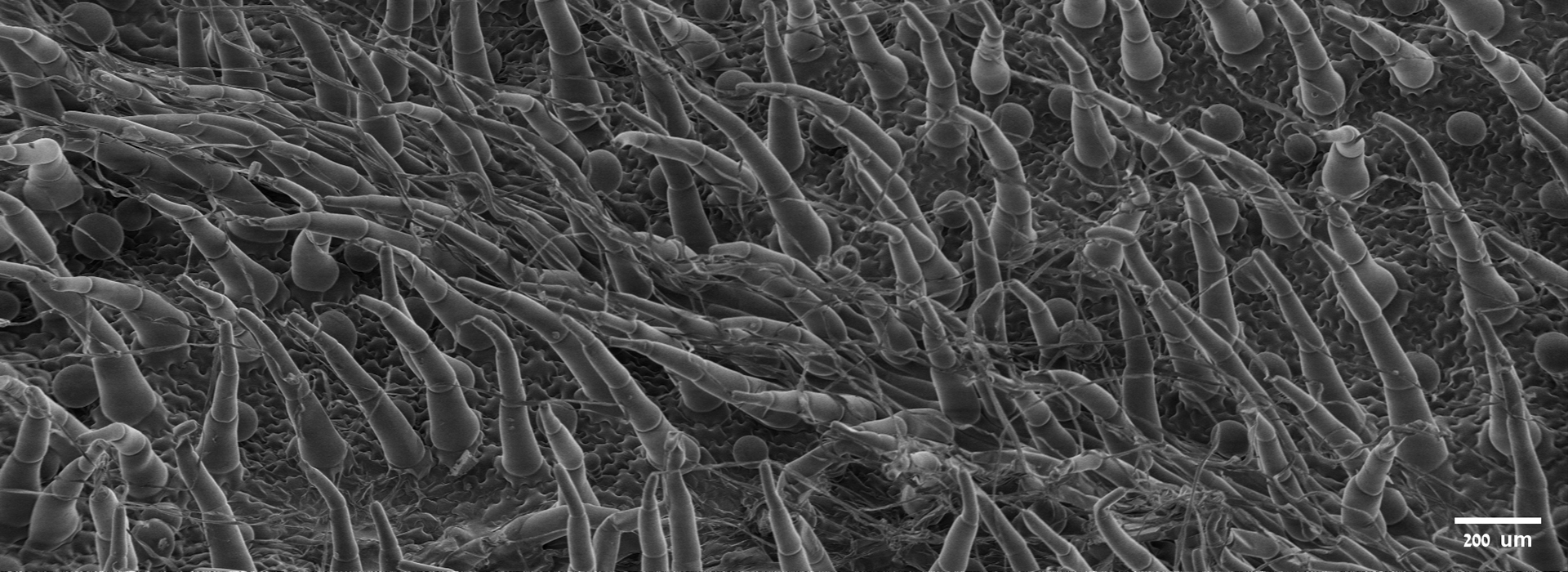Plant research reaches a new high
The familiar cannabis plant makes more than 100 different chemical compounds known as cannabinoids, and it remains their iconic producer. But the woolly umbrella, a fast-growing perennial plant from South Africa, is a respectable runner-up. Although completely unrelated to the cannabis plant, it produces a slew of cannabinoids, including some that may have new medical uses.
In a study published in 2023 in Nature Plants, Weizmann researchers led by Prof. Asaph Aharoni from the Department of Plant and Environmental Sciences identified more than 40 cannabinoids in the woolly umbrella and revealed the series of biochemical steps the plant takes when it makes these compounds. The researchers also showed how these steps can be reproduced in the lab to synthesize or even engineer new cannabinoids.
Cannabinoids are already widely applied to relieve pain, nausea, anxiety, and epileptic seizures, and the list of their possible uses is rapidly growing. Molecular receptors that respond to these compounds are common in humans, not only in the brain but also throughout the body, suggesting that the cannabinoids that bind to them could potentially be used to treat everything from cancer to neurodegenerative diseases.
The promise for medicine is precisely why the Aharoni lab launched a study of the woolly umbrella. The plant has long been known to be burned in folk rituals in Asia, Africa, and Europe to release intoxicating fumes, which suggested that it might contain chemicals affecting the brain. In fact, German scientists who studied the plant more than 40 years ago found evidence that it contains cannabinoids, but more modern studies failed to reproduce their findings.
Now, Prof. Aharoni and his team have confirmed that early report. They sequenced the entire genome of the woolly umbrella and used advanced analytical chemistry, including high-resolution mass spectroscopy, to identify the kinds of cannabinoids it contains. Using nuclear magnetic resonance, the researchers revealed the precise structure of more than a dozen of these cannabinoids and other related metabolites. They traced the entire biochemical pathway involved in the production of cannabinoids and determined where in the plant they are made.
It turns out that the woolly umbrella manufactures cannabinoids primarily in its leaves, possibly giving it an economic advantage over cannabis, which means these compounds are in the shorter-lived and harder-to-harvest flower clusters. Despite this difference, the scientists found a great deal of commonality between the two plants, particularly in terms of the enzymes involved in cannabinoid production.
Six of the cannabinoids found in the woolly umbrella are identical to those in cannabis—and while that list excludes the most infamous two, THC and CBD, it does include cannabigerol, or CBG, a rising star of cannabinoid research. CBG has potential therapeutic applications but lacks mood-altering effects. The acid form of CBG, which appears in a relatively high concentration in the plant, serves as a precursor to produce all the classical cannabinoids, supporting the idea that the woolly umbrella could become a valuable source of plant-based cannabinoids.
The Aharoni team has already taken their latest insights into cannabinoid genetics a step further, using their findings to generate the newly discovered cannabinoid-making enzymes in tobacco plants. The researchers also managed to use these enzymes to create finished cannabinoids in yeast, pointing to a new way of manufacturing the compounds for research and the biotech industry.

Prof. Asaph Aharoni is Head of the Melvyn A. Dobrin Center for Nutrition and Plant Research, Head of the Charles W. & Tillie K. Lubin Center for Plant Biotechnology, and Head of the Harry and Jeanette Weinberg Center for Plant Molecular Genetics Research. His research is supported by the Laura Gurwin Flug Family Foundation, the Tom and Sondra Rykoff Family Foundation, and the Wolfson Family Charitable Trust & Wolfson Foundation. Prof. Aharoni is the incumbent of the Peter J. Cohn Professorial Chair.
